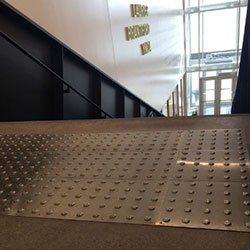









In Canada, fostering inclusivity and accessibility is not just important - it's the law. With approximately 6.2 million Canadians living with some form of disability, the need for accessible infrastructure and environments has never been greater. Tactile warning systems are pivotal in enhancing accessibility and independence for Canadians with visual impairments.
As a contractor or building owner, understanding the various accessibility codes and standards is critical to ensuring your projects are compliant and accommodate all users. This blog post explores the critical accessibility codes in Canada, why tactile warning systems are vital, and how products from Tactile Solutions Canada can equip you for success.
The AODA is provincial legislation passed in 2005 to improve accessibility across Ontario for persons with disabilities. This act serves as the foundation and framework for developing accessibility standards that address barriers faced by Ontarians in key areas of daily living.
AODA's Design of Public Spaces standard directly pertains to tactile warning systems. It mandates that all newly constructed or redeveloped public spaces must be made accessible for persons with disabilities.
The standard applies to all newly constructed public spaces and existing spaces undergoing major renovations. It also applies to both public and private sector organizations above a certain size.
This far-reaching standard underscore why installing compliant tactile warning systems is not just good practice, but the law.
The CSA B651 is a nationally recognized standard developed by the CSA Group that provides technical requirements for creating accessible built environments. Tactile walking surface indicators (TWSIs) comprise a crucial element addressed within this standard.
CSA B651 outlines the correct specifications and placement guidelines for TWSIs to accommodate persons with visual disabilities. It covers warning/attention TWSIs that indicate hazards and directional/guidance TWSIs that guide users along a path.
Adhering to CSA B651 ensures the proper application of tactile systems to create consistently accessible and navigable spaces.
The National Building Code of Canada prescribes technical provisions for designing and constructing new buildings, including various accessibility requirements. It references both AODA regulations and CSA standards, including CSA B651.
Tactile warning surfaces facilitate compliance in critical areas like washrooms, paths of travel, parking areas, and emergency egress routes. Installing code-compliant tactile systems is necessary to satisfy National Building Code requirements.
Tactile warning systems provide standardized walking surfaces with a detectable texture and cues that alert pedestrians to potential hazards or guide them along an intended route. For individuals with visual disabilities, these vital systems foster improved mobility and independence.
The key benefits of compliant tactile warning systems include the following:
Tactile indicators like truncated domes provide critical underfoot warnings about potential dangers such as platform edges, street crossings, transit boarding zones, or staircases. This allows improved navigation and hazard avoidance for persons with vision loss.
Properly installed tactile warning systems satisfy the accessibility requirements mandated under Canadian codes and regulations like the AODA, NBC, CSA B651, and various provincial codes. This ensures that projects adhere to the law and promote inclusion.
The unique textures and patterns of tactile walking surface indicators enable persons with visual disabilities to gather vital spatial information about their surroundings using touch and other senses. This allows for confident wayfinding and exploration without reliance on aids like canes.
Standardized tactile warning guidelines help maintain consistency in how warnings and directional cues are conveyed. This consistency enables quicker interpretation and leaves less room for error in navigating spaces.
Tactile warning products are available in a range of materials, sizes, colors, and patterns to accommodate diverse projects and design aesthetics both indoors and outdoors. Easy installation and low maintenance also make them a versatile accessibility solution.
As Canada's leading supplier of code-compliant tactile warning systems, Tactile Solution Canada aims to empower contractors, building owners, architects, and public authorities to create accessible environments that accommodate all Canadians.
Our extensive product portfolio includes trusted solutions like:
These industry-leading solutions are:
With the guidance of our accessibility specialists, you can select optimal tactile warning systems for all your projects and applications with full confidence in meeting Canadian codes. Contact our team today to learn how Tactile Solution Canada can become your trusted partner in accessibility.
A: The major codes are the Accessibility for Ontarians with Disabilities Act (AODA), the National Building Code of Canada, CSA B651, and various provincial regulations like the Ontario Building Code.
A: Key locations include transit platforms, pedestrian crossings, building entrances, stairs, ramps, escalators, parking areas, passenger loading zones, and restrooms.
A: Properly installed systems require very minimal maintenance beyond occasional cleaning. High-quality tiles have long lifespans of 25+ years.
A: Surface-applied tiles are designed specifically for easy application onto existing flooring. These provide a cost-effective retrofitting solution.
